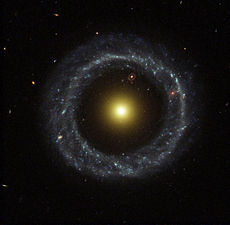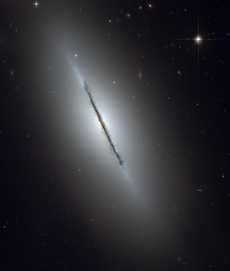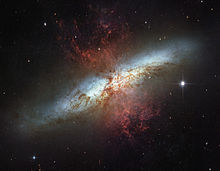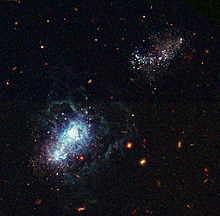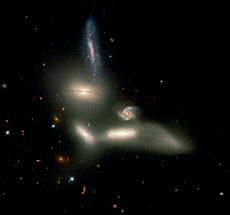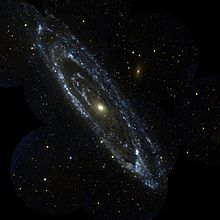- Galaxy
-
This article is about the astronomical structure. For other uses, see Galaxy (disambiguation).
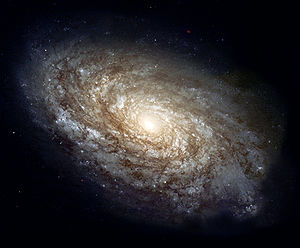 NGC 4414, a typical spiral galaxy in the constellation Coma Berenices, is about 55,000 light-years in diameter and approximately 60 million light-years away from Earth.
NGC 4414, a typical spiral galaxy in the constellation Coma Berenices, is about 55,000 light-years in diameter and approximately 60 million light-years away from Earth.
A galaxy is a massive, gravitationally bound system that consists of stars and stellar remnants, an interstellar medium of gas and dust, and an important but poorly understood component tentatively dubbed dark matter.[1][2] The word galaxy is derived from the Greek galaxias [γαλαξίας], literally "milky", a reference to the Milky Way galaxy. Examples of galaxies range from dwarfs with as few as ten million (107) stars[3] to giants with a hundred trillion (1014) stars,[4] each orbiting their galaxy's own center of mass.
Galaxies contain varying amounts of star systems, star clusters and types of interstellar clouds. In between these objects is a sparse interstellar medium of gas, dust, and cosmic rays. Dark matter appears to account for around 90% of the mass of most galaxies. Observational data suggests that supermassive black holes may exist at the center of many, if not all, galaxies. They are thought to be the primary driver of active galactic nuclei found at the core of some galaxies. The Milky Way galaxy appears to harbor at least one such object.[5]
Galaxies have been historically categorized according to their apparent shape; usually referred to as their visual morphology. A common form is the elliptical galaxy,[6] which has an ellipse-shaped light profile. Spiral galaxies are disk-shaped with dusty, curving arms. Those with irregular or unusual shapes are known as irregular galaxies and typically originate from disruption by the gravitational pull of neighboring galaxies. Such interactions between nearby galaxies, which may ultimately result in a merging, sometimes induce significantly increased incidents of star formation leading starburst galaxys. Smaller galaxies lacking a coherent structure are referred to as irregular galaxies.[7]
There are probably more than 170 billion (1.7 × 1011) galaxies in the observable universe.[8][9] Most are 1,000 to 100,000[10] parsecs in diameter and usually separated by distances on the order of millions of parsecs (or megaparsecs).[11] Intergalactic space (the space between galaxies) is filled with a tenuous gas of an average density less than one atom per cubic meter. The majority of galaxies are organized into a hierarchy of associations known as groups and clusters, which, in turn usually form larger superclusters. At the largest scale, these associations are generally arranged into sheets and filaments, which are surrounded by immense voids.[12]
Contents
Etymology
The word galaxy derives from the Greek term for our own galaxy, galaxias (γαλαξίας), or kyklos galaktikos, meaning "milky circle"[13] for its appearance in the sky. In Greek mythology, Zeus places his son born by a mortal woman, the infant Heracles, on Hera's breast while she is asleep so that the baby will drink her divine milk and will thus become immortal. Hera wakes up while breastfeeding and then realizes she is nursing an unknown baby: she pushes the baby away and a jet of her milk sprays the night sky, producing the faint band of light known as the Milky Way.[14][15]
In the astronomical literature, the capitalized word 'Galaxy' is used to refer to our galaxy, the Milky Way, to distinguish it from the billions of other galaxies. The term Milky Way first appeared in the English language in a story by Chaucer.
"See yonder, lo, the Galaxyë
Which men clepeth the Milky Wey,
For hit is whyt."—Geoffrey Chaucer. The House of Fame, c. 1380.[13]When William Herschel constructed his catalog of deep sky objects in 1786, he used the name spiral nebula for certain objects such as M31. These would later be recognized as immense conglomerations of stars, when the true distance to these objects began to be appreciated, and they would be termed island universes. However, the word Universe was understood to mean the entirety of existence, so this expression fell into disuse and the objects instead became known as galaxies.[16]
Observation history
The realization that we live in a galaxy, and that there were, in fact, many other galaxies, parallels discoveries that were made about the Milky Way and other nebulae in the night sky.
The Milky Way
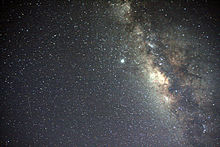 Galactic Center of the Milky Way
Galactic Center of the Milky Way
The Greek philosopher Democritus (450–370 BC) proposed that the bright band on the night sky known as the Milky Way might consist of distant stars.[17] Aristotle (384–322 BC), however, believed the Milky Way to be caused by "the ignition of the fiery exhalation of some stars which were large, numerous and close together" and that the "ignition takes place in the upper part of the atmosphere, in the region of the world which is continuous with the heavenly motions."[18] The Neoplatonist philosopher Olympiodorus the Younger (c. 495–570 AD) criticized this view, arguing that if the Milky Way were sublunary it should appear different at different times and places on the Earth, and that it should have parallax, which it does not. In his view, the Milky Way was celestial. This idea would be influential later in the Islamic world.[19]
The Arabian astronomer, Alhazen (965–1037), made the first attempt at observing and measuring the Milky Way's parallax,[20] and he thus "determined that because the Milky Way had no parallax, it was very remote from the Earth and did not belong to the atmosphere."[21] The Persian astronomer Abū Rayhān al-Bīrūnī (973–1048) proposed the Milky Way galaxy to be "a collection of countless fragments of the nature of nebulous stars."[22][23] The Andalusian astronomer Ibn Bajjah ("Avempace", d. 1138) proposed that the Milky Way was made up of many stars that almost touch one another and appear to be a continuous image due to the effect of refraction from sublunary material,[18][24] citing his observation of the conjunction of Jupiter and Mars as evidence of this occurring when two objects are near.[18] The Syrian-born Ibn Qayyim Al-Jawziyya (1292–1350) proposed the Milky Way galaxy to be "a myriad of tiny stars packed together in the sphere of the fixed stars".[25]
Actual proof of the Milky Way consisting of many stars came in 1610 when Galileo Galilei used a telescope to study the Milky Way and discovered that it is composed of a huge number of faint stars.[26] In 1750 Thomas Wright, in his An original theory or new hypothesis of the Universe, speculated (correctly) that the galaxy might be a rotating body of a huge number of stars held together by gravitational forces, akin to the solar system but on a much larger scale. The resulting disk of stars can be seen as a band on the sky from our perspective inside the disk.[27] In a treatise in 1755, Immanuel Kant elaborated on Wright's idea about the structure of the Milky Way.
The first attempt to describe the shape of the Milky Way and the position of the Sun in it was carried out by William Herschel in 1785 by carefully counting the number of stars in different regions of the sky. He produced a diagram of the shape of the galaxy with the solar system close to the center.[28] Using a refined approach, Kapteyn in 1920 arrived at the picture of a small (diameter about 15 kiloparsecs) ellipsoid galaxy with the Sun close to the center. A different method by Harlow Shapley based on the cataloguing of globular clusters led to a radically different picture: a flat disk with diameter approximately 70 kiloparsecs and the Sun far from the center.[27] Both analyses failed to take into account the absorption of light by interstellar dust present in the galactic plane, but after Robert Julius Trumpler quantified this effect in 1930 by studying open clusters, the present picture of our galaxy, the Milky Way, emerged.[29]
Distinction from other nebulae
In the 10th century, the Persian astronomer, Abd al-Rahman al-Sufi (known in the West as Azophi), made the earliest recorded observation of the Andromeda Galaxy, describing it as a "small cloud".[30] Al-Sufi also identified the Large Magellanic Cloud, which is visible from Yemen, though not from Isfahan; it was not seen by Europeans until Magellan's voyage in the 16th century.[31][32] These were the first galaxies other than the Milky Way to be observed from Earth. Al-Sufi published his findings in his Book of Fixed Stars in 964.
In 1750 Thomas Wright, in his An original theory or new hypothesis of the Universe, speculated (correctly) that Milky Way was a flattened disk of stars, and that some of the nebulae visible in the night sky might be separate Milky Ways.[27][33] In 1755 Immanuel Kant introduced the term "island universe" for these distant nebulae.
Toward the end of the 18th century, Charles Messier compiled a catalog containing the 109 brightest nebulae (celestial objects with a nebulous appearance), later followed by a larger catalog of 5,000 nebulae assembled by William Herschel.[27] In 1845, Lord Rosse constructed a new telescope and was able to distinguish between elliptical and spiral nebulae. He also managed to make out individual point sources in some of these nebulae, lending credence to Kant's earlier conjecture.[34]
In 1912, Vesto Slipher made spectrographic studies of the brightest spiral nebulae to determine if they were made from chemicals that would be expected in a planetary system. However, Slipher discovered that the spiral nebulae had high red shifts, indicating that they were moving away at rate higher than the Milky Way's escape velocity. Thus they were not gravitationally bound to the Milky Way, and were unlikely to be a part of the galaxy.[35][36]
In 1917, Heber Curtis had observed a nova S Andromedae within the "Great Andromeda Nebula" (Messier object M31). Searching the photographic record, he found 11 more novae. Curtis noticed that these novae were, on average, 10 magnitudes fainter than those that occurred within our galaxy. As a result he was able to come up with a distance estimate of 150,000 parsecs. He became a proponent of the so-called "island universes" hypothesis, which holds that spiral nebulae are actually independent galaxies.[37]
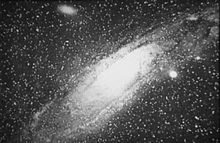 Photograph of the "Great Andromeda Nebula" from 1899, later identified as the Andromeda Galaxy
Photograph of the "Great Andromeda Nebula" from 1899, later identified as the Andromeda Galaxy
In 1920 the so-called Great Debate took place between Harlow Shapley and Heber Curtis, concerning the nature of the Milky Way, spiral nebulae, and the dimensions of the Universe. To support his claim that the Great Andromeda Nebula was an external galaxy, Curtis noted the appearance of dark lanes resembling the dust clouds in the Milky Way, as well as the significant Doppler shift.[38]
The matter was conclusively settled in the early 1920s. In 1922, astronomer Ernst Öpik gave a distance determination which supported the theory that the Andromeda Nebula is indeed a distant extra-galactic object.[39] Using the new 100 inch Mt. Wilson telescope, Edwin Hubble was able to resolve the outer parts of some spiral nebulae as collections of individual stars and identified some Cepheid variables, thus allowing him to estimate the distance to the nebulae: they were far too distant to be part of the Milky Way.[40] In 1936 Hubble produced a classification system for galaxies that is used to this day, the Hubble sequence.[41]
Modern research
 Rotation curve of a typical spiral galaxy: predicted (A) and observed (B). The distance is from the galactic core.
Rotation curve of a typical spiral galaxy: predicted (A) and observed (B). The distance is from the galactic core.
In 1944, Hendrik van de Hulst predicted microwave radiation at a wavelength of 21 cm resulting from interstellar atomic hydrogen gas;[42] this radiation was observed in 1951. The radiation allowed for much improved study of the Milky Way Galaxy, since it is not affected by dust absorption and its Doppler shift can be used to map the motion of the gas in the Galaxy. These observations led to the postulation of a rotating bar structure in the center of the Galaxy.[43] With improved radio telescopes, hydrogen gas could also be traced in other galaxies.
In the 1970s it was discovered in Vera Rubin's study of the rotation speed of gas in galaxies that the total visible mass (from the stars and gas) does not properly account for the speed of the rotating gas. This galaxy rotation problem is thought to be explained by the presence of large quantities of unseen dark matter.[44][45]
Beginning in the 1990s, the Hubble Space Telescope yielded improved observations. Among other things, it established that the missing dark matter in our galaxy cannot solely consist of inherently faint and small stars.[46] The Hubble Deep Field, an extremely long exposure of a relatively empty part of the sky, provided evidence that there are about 125 billion (1.25×1011) galaxies in the universe.[47] Improved technology in detecting the spectra invisible to humans (radio telescopes, infrared cameras, and x-ray telescopes) allow detection of other galaxies that are not detected by Hubble. Particularly, galaxy surveys in the Zone of Avoidance (the region of the sky blocked by the Milky Way) have revealed a number of new galaxies.[48]
Types and morphology
Main article: Galaxy morphological classification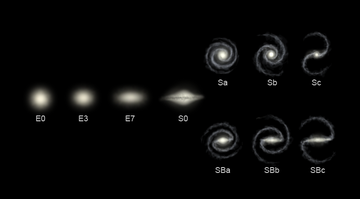 Types of galaxies according to the Hubble classification scheme. An E indicates a type of elliptical galaxy; an S is a spiral; and SB is a barred-spiral galaxy.[note 1]
Types of galaxies according to the Hubble classification scheme. An E indicates a type of elliptical galaxy; an S is a spiral; and SB is a barred-spiral galaxy.[note 1]
Galaxies come in three main types: ellipticals, spirals, and irregulars. A slightly more extensive description of galaxy types based on their appearance is given by the Hubble sequence. Since the Hubble sequence is entirely based upon visual morphological type, it may miss certain important characteristics of galaxies such as star formation rate (in starburst galaxies) and activity in the core (in active galaxies).[7]
Ellipticals
Main article: Elliptical galaxyThe Hubble classification system rates elliptical galaxies on the basis of their ellipticity, ranging from E0, being nearly spherical, up to E7, which is highly elongated. These galaxies have an ellipsoidal profile, giving them an elliptical appearance regardless of the viewing angle. Their appearance shows little structure and they typically have relatively little interstellar matter. Consequently these galaxies also have a low portion of open clusters and a reduced rate of new star formation. Instead they are dominated by generally older, more evolved stars that are orbiting the common center of gravity in random directions. In this sense they have some similarity to the much smaller globular clusters.[49]
The largest galaxies are giant ellipticals. Many elliptical galaxies are believed to form due to the interaction of galaxies, resulting in a collision and merger. They can grow to enormous sizes (compared to spiral galaxies, for example), and giant elliptical galaxies are often found near the core of large galaxy clusters.[50] Starburst galaxies are the result of such a galactic collision that can result in the formation of an elliptical galaxy.[49]
Spirals
Main articles: Spiral galaxy and Barred spiral galaxy The Whirlpool Galaxy (on left), an example of an unbarred spiral galaxy.
The Whirlpool Galaxy (on left), an example of an unbarred spiral galaxy.
Spiral galaxies consist of a rotating disk of stars and interstellar medium, along with a central bulge of generally older stars. Extending outward from the bulge are relatively bright arms. In the Hubble classification scheme, spiral galaxies are listed as type S, followed by a letter (a, b, or c) that indicates the degree of tightness of the spiral arms and the size of the central bulge. An Sa galaxy has tightly wound, poorly defined arms and possesses a relatively large core region. At the other extreme, an Sc galaxy has open, well-defined arms and a small core region.[51] A galaxy with poorly defined arms is sometimes referred to as a flocculent spiral galaxy; in contrast to the grand design spiral galaxy that has prominent and well-defined spiral arms.[52]
In spiral galaxies, the spiral arms do have the shape of approximate logarithmic spirals, a pattern that can be theoretically shown to result from a disturbance in a uniformly rotating mass of stars. Like the stars, the spiral arms rotate around the center, but they do so with constant angular velocity. The spiral arms are thought to be areas of high density matter, or "density waves".[53] As stars move through an arm, the space velocity of each stellar system is modified by the gravitational force of the higher density. (The velocity returns to normal after the stars depart on the other side of the arm.) This effect is akin to a "wave" of slowdowns moving along a highway full of moving cars. The arms are visible because the high density facilitates star formation, and therefore they harbor many bright and young stars.[54]
 NGC 1300, an example of a barred spiral galaxy.
NGC 1300, an example of a barred spiral galaxy.
A majority of spiral galaxies have a linear, bar-shaped band of stars that extends outward to either side of the core, then merges into the spiral arm structure.[55] In the Hubble classification scheme, these are designated by an SB, followed by a lower-case letter (a, b or c) that indicates the form of the spiral arms (in the same manner as the categorization of normal spiral galaxies). Bars are thought to be temporary structures that can occur as a result of a density wave radiating outward from the core, or else due to a tidal interaction with another galaxy.[56] Many barred spiral galaxies are active, possibly as a result of gas being channeled into the core along the arms.[57]
Our own galaxy is a large disk-shaped barred-spiral galaxy[58] about 30 kiloparsecs in diameter and a kiloparsec in thickness. It contains about two hundred billion (2×1011)[59] stars and has a total mass of about six hundred billion (6×1011) times the mass of the Sun.[60]
Other morphologies
Hoag's Object, an example of a ring galaxyNGC 5866, an example of a lenticular galaxyPeculiar galaxies are galactic formations that develop unusual properties due to tidal interactions with other galaxies. An example of this is the ring galaxy, which possesses a ring-like structure of stars and interstellar medium surrounding a bare core. A ring galaxy is thought to occur when a smaller galaxy passes through the core of a spiral galaxy.[61] Such an event may have affected the Andromeda Galaxy, as it displays a multi-ring-like structure when viewed in infrared radiation.[62]
A lenticular galaxy is an intermediate form that has properties of both elliptical and spiral galaxies. These are categorized as Hubble type S0, and they possess ill-defined spiral arms with an elliptical halo of stars.[63] (Barred lenticular galaxies receive Hubble classification SB0.)
In addition to the classifications mentioned above, there are a number of galaxies that can not be readily classified into an elliptical or spiral morphology. These are categorized as irregular galaxies. An Irr-I galaxy has some structure but does not align cleanly with the Hubble classification scheme. Irr-II galaxies do not possess any structure that resembles a Hubble classification, and may have been disrupted.[64] Nearby examples of (dwarf) irregular galaxies include the Magellanic Clouds.
Dwarfs
Main article: Dwarf galaxyDespite the prominence of large elliptical and spiral galaxies, most galaxies in the universe appear to be dwarf galaxies. These galaxies are relatively small when compared with other galactic formations, being about one hundredth the size of the Milky Way, containing only a few billion stars. Ultra-compact dwarf galaxies have recently been discovered that are only 100 parsecs across.[65]
Many dwarf galaxies may orbit a single larger galaxy; the Milky Way has at least a dozen such satellites, with an estimated 300–500 yet to be discovered.[66] Dwarf galaxies may also be classified as elliptical, spiral, or irregular. Since small dwarf ellipticals bear little resemblance to large ellipticals, they are often called dwarf spheroidal galaxies instead.
A study of 27 Milky Way neighbors found that in all dwarf galaxies, the central mass is approximately 10 million solar masses, regardless of whether the galaxy has thousands or millions of stars. This has led to the suggestion that galaxies are largely formed by dark matter, and that the minimum size may indicate a form of warm dark matter incapable of gravitational coalescence on a smaller scale.[67]
Unusual dynamics and activities
Interacting
Main article: Interacting galaxyThe average separation between galaxies within a cluster is a little over an order of magnitude larger than their diameter. Hence interactions between these galaxies are relatively frequent, and play an important role in their evolution. Near misses between galaxies result in warping distortions due to tidal interactions, and may cause some exchange of gas and dust.[68][69]
 The Antennae Galaxies are undergoing a collision that will result in their eventual merger.
The Antennae Galaxies are undergoing a collision that will result in their eventual merger.
Collisions occur when two galaxies pass directly through each other and have sufficient relative momentum not to merge. The stars within these interacting galaxies will typically pass straight through without colliding. However, the gas and dust within the two forms will interact. This can trigger bursts of star formation as the interstellar medium becomes disrupted and compressed. A collision can severely distort the shape of one or both galaxies, forming bars, rings or tail-like structures.[68][69]
At the extreme of interactions are galactic mergers. In this case the relative momentum of the two galaxies is insufficient to allow the galaxies to pass through each other. Instead, they gradually merge together to form a single, larger galaxy. Mergers can result in significant changes to morphology, as compared to the original galaxies. In the case where one of the galaxies is much more massive, however, the result is known as cannibalism. In this case the larger galaxy will remain relatively undisturbed by the merger, while the smaller galaxy is torn apart. The Milky Way galaxy is currently in the process of cannibalizing the Sagittarius Dwarf Elliptical Galaxy and the Canis Major Dwarf Galaxy.[68][69]
Starburst
Main article: Starburst galaxyStars are created within galaxies from a reserve of cold gas that forms into giant molecular clouds. Some galaxies have been observed to form stars at an exceptional rate, known as a starburst. Should they continue to do so, however, they would consume their reserve of gas in a time frame lower than the lifespan of the galaxy. Hence starburst activity usually lasts for only about ten million years, a relatively brief period in the history of a galaxy. Starburst galaxies were more common during the early history of the universe,[71] and, at present, still contribute an estimated 15% to the total star production rate.[72]
Starburst galaxies are characterized by dusty concentrations of gas and the appearance of newly formed stars, including massive stars that ionize the surrounding clouds to create H II regions.[73] These massive stars produce supernova explosions, resulting in expanding remnants that interact powerfully with the surrounding gas. These outbursts trigger a chain reaction of star building that spreads throughout the gaseous region. Only when the available gas is nearly consumed or dispersed does the starburst activity come to an end.[71]
Starbursts are often associated with merging or interacting galaxies. The prototype example of such a starburst-forming interaction is M82, which experienced a close encounter with the larger M81. Irregular galaxies often exhibit spaced knots of starburst activity.[74]
Active nucleus
Main article: Active galactic nucleusA portion of the galaxies we can observe are classified as active. That is, a significant portion of the total energy output from the galaxy is emitted by a source other than the stars, dust and interstellar medium.
The standard model for an active galactic nucleus is based upon an accretion disc that forms around a supermassive black hole (SMBH) at the core region. The radiation from an active galactic nucleus results from the gravitational energy of matter as it falls toward the black hole from the disc.[75] In about 10% of these objects, a diametrically opposed pair of energetic jets ejects particles from the core at velocities close to the speed of light. The mechanism for producing these jets is still not well understood.[76]
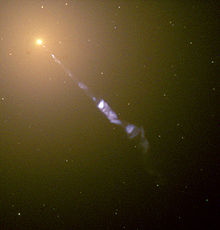 A jet of particles is being emitted from the core of the elliptical radio galaxy M87.
A jet of particles is being emitted from the core of the elliptical radio galaxy M87.
Active galaxies that emit high-energy radiation in the form of x-rays are classified as Seyfert galaxies or quasars, depending on the luminosity. Blazars are believed to be an active galaxy with a relativistic jet that is pointed in the direction of the Earth. A radio galaxy emits radio frequencies from relativistic jets. A unified model of these types of active galaxies explains their differences based on the viewing angle of the observer.[76]
Possibly related to active galactic nuclei (as well as starburst regions) are low-ionization nuclear emission-line regions (LINERs). The emission from LINER-type galaxies is dominated by weakly ionized elements.[77] Approximately one-third of nearby galaxies are classified as containing LINER nuclei.[75][77][78]
Formation and evolution
Main article: Galaxy formation and evolutionThe study of galactic formation and evolution attempts to answer questions regarding how galaxies formed and their evolutionary path over the history of the universe. Some theories in this field have now become widely accepted, but it is still an active area in astrophysics.
Formation
Current cosmological models of the early Universe are based on the Big Bang theory. About 300,000 years after this event, atoms of hydrogen and helium began to form, in an event called recombination. Nearly all the hydrogen was neutral (non-ionized) and readily absorbed light, and no stars had yet formed. As a result this period has been called the "Dark Ages". It was from density fluctuations (or anisotropic irregularities) in this primordial matter that larger structures began to appear. As a result, masses of baryonic matter started to condense within cold dark matter halos.[79][80] These primordial structures would eventually become the galaxies we see today.
Evidence for the early appearance of galaxies was found in 2006, when it was discovered that the galaxy IOK-1 has an unusually high redshift of 6.96, corresponding to just 750 million years after the Big Bang and making it the most distant and primordial galaxy yet seen.[81] While some scientists have claimed other objects (such as Abell 1835 IR1916) have higher redshifts (and therefore are seen in an earlier stage of the Universe's evolution), IOK-1's age and composition have been more reliably established. The existence of such early protogalaxies suggests that they must have grown in the so-called "Dark Ages".[79]
The detailed process by which such early galaxy formation occurred is a major open question in astronomy. Theories could be divided into two categories: top-down and bottom-up. In top-down theories (such as the Eggen–Lynden-Bell–Sandage [ELS] model), protogalaxies form in a large-scale simultaneous collapse lasting about one hundred million years.[82] In bottom-up theories (such as the Searle-Zinn [SZ] model), small structures such as globular clusters form first, and then a number of such bodies accrete to form a larger galaxy.[83]
Once protogalaxies began to form and contract, the first halo stars (called Population III stars) appeared within them. These were composed almost entirely of hydrogen and helium, and may have been massive. If so, these huge stars would have quickly consumed their supply of fuel and became supernovae, releasing heavy elements into the interstellar medium.[84] This first generation of stars re-ionized the surrounding neutral hydrogen, creating expanding bubbles of space through which light could readily travel.[85]
Evolution
Within a billion years of a galaxy's formation, key structures begin to appear. Globular clusters, the central supermassive black hole, and a galactic bulge of metal-poor Population II stars form. The creation of a supermassive black hole appears to play a key role in actively regulating the growth of galaxies by limiting the total amount of additional matter added.[88] During this early epoch, galaxies undergo a major burst of star formation.[89]
During the following two billion years, the accumulated matter settles into a galactic disc.[90] A galaxy will continue to absorb infalling material from high-velocity clouds and dwarf galaxies throughout its life.[91] This matter is mostly hydrogen and helium. The cycle of stellar birth and death slowly increases the abundance of heavy elements, eventually allowing the formation of planets.[92]
The evolution of galaxies can be significantly affected by interactions and collisions. Mergers of galaxies were common during the early epoch, and the majority of galaxies were peculiar in morphology.[93] Given the distances between the stars, the great majority of stellar systems in colliding galaxies will be unaffected. However, gravitational stripping of the interstellar gas and dust that makes up the spiral arms produces a long train of stars known as tidal tails. Examples of these formations can be seen in NGC 4676[94] or the Antennae Galaxies.[95]
As an example of such an interaction, the Milky Way galaxy and the nearby Andromeda Galaxy are moving toward each other at about 130 km/s, and—depending upon the lateral movements—the two may collide in about five to six billion years. Although the Milky Way has never collided with a galaxy as large as Andromeda before, evidence of past collisions of the Milky Way with smaller dwarf galaxies is increasing.[96]
Such large-scale interactions are rare. As time passes, mergers of two systems of equal size become less common. Most bright galaxies have remained fundamentally unchanged for the last few billion years, and the net rate of star formation probably also peaked approximately ten billion years ago.[97]
Future trends
At present, most star formation occurs in smaller galaxies where cool gas is not so depleted.[93] Spiral galaxies, like the Milky Way, only produce new generations of stars as long as they have dense molecular clouds of interstellar hydrogen in their spiral arms.[98] Elliptical galaxies are already largely devoid of this gas, and so form no new stars.[99] The supply of star-forming material is finite; once stars have converted the available supply of hydrogen into heavier elements, new star formation will come to an end.[100]
The current era of star formation is expected to continue for up to one hundred billion years, and then the "stellar age" will wind down after about ten trillion to one hundred trillion years (1013–1014 years), as the smallest, longest-lived stars in our astrosphere, tiny red dwarfs, begin to fade. At the end of the stellar age, galaxies will be composed of compact objects: brown dwarfs, white dwarfs that are cooling or cold ("black dwarfs"), neutron stars, and black holes. Eventually, as a result of gravitational relaxation, all stars will either fall into central supermassive black holes or be flung into intergalactic space as a result of collisions.[100][101]
Larger-scale structures
Main articles: Large-scale structure of the cosmos and Groups and clusters of galaxiesDeep sky surveys show that galaxies are often found in relatively close association with other galaxies. Solitary galaxies that have not significantly interacted with another galaxy of comparable mass during the past billion years are relatively scarce. Only about 5% of the galaxies surveyed have been found to be truly isolated; however, these isolated formations may have interacted and even merged with other galaxies in the past, and may still be orbited by smaller, satellite galaxies. Isolated galaxies[note 2] can produce stars at a higher rate than normal, as their gas is not being stripped by other nearby galaxies.[102]
On the largest scale, the universe is continually expanding, resulting in an average increase in the separation between individual galaxies (see Hubble's law). Associations of galaxies can overcome this expansion on a local scale through their mutual gravitational attraction. These associations formed early in the universe, as clumps of dark matter pulled their respective galaxies together. Nearby groups later merged to form larger-scale clusters. This on-going merger process (as well as an influx of infalling gas) heats the inter-galactic gas within a cluster to very high temperatures, reaching 30–100 megakelvins.[103] About 70–80% of the mass in a cluster is in the form of dark matter, with 10–30% consisting of this heated gas and the remaining few percent of the matter in the form of galaxies.[104]
Seyfert's Sextet is an example of a compact galaxy group.Most galaxies in the universe are gravitationally bound to a number of other galaxies. These form a fractal-like hierarchy of clustered structures, with the smallest such associations being termed groups. A group of galaxies is the most common type of galactic cluster, and these formations contain a majority of the galaxies (as well as most of the baryonic mass) in the universe.[105][106] To remain gravitationally bound to such a group, each member galaxy must have a sufficiently low velocity to prevent it from escaping (see Virial theorem). If there is insufficient kinetic energy, however, the group may evolve into a smaller number of galaxies through mergers.[107]
Larger structures containing many thousands of galaxies packed into an area a few megaparsecs across are called clusters. Clusters of galaxies are often dominated by a single giant elliptical galaxy, known as the brightest cluster galaxy, which, over time, tidally destroys its satellite galaxies and adds their mass to its own.[108]
Superclusters contain tens of thousands of galaxies, which are found in clusters, groups and sometimes individually. At the supercluster scale, galaxies are arranged into sheets and filaments surrounding vast empty voids.[109] Above this scale, the universe appears to be isotropic and homogeneous.[110]
The Milky Way galaxy is a member of an association named the Local Group, a relatively small group of galaxies that has a diameter of approximately one megaparsec. The Milky Way and the Andromeda Galaxy are the two brightest galaxies within the group; many of the other member galaxies are dwarf companions of these two galaxies.[111] The Local Group itself is a part of a cloud-like structure within the Virgo Supercluster, a large, extended structure of groups and clusters of galaxies centered around the Virgo Cluster.[112]
Multi-wavelength observation
See also: Observational astronomyA visual light image of Andromeda Galaxy shows the emission of ordinary stars and the light reflected by dust.After galaxies external to the Milky Way were found to exist, initial observations were made mostly using visible light. The peak radiation of most stars lies here, so the observation of the stars that form galaxies has been a major component of optical astronomy. It is also a favorable portion of the spectrum for observing ionized H II regions, and for examining the distribution of dusty arms.
The dust present in the interstellar medium is opaque to visual light. It is more transparent to far-infrared, which can be used to observe the interior regions of giant molecular clouds and galactic cores in great detail.[113] Infrared is also used to observe distant, red-shifted galaxies that were formed much earlier in the history of the universe. Water vapor and carbon dioxide absorb a number of useful portions of the infrared spectrum, so high-altitude or space-based telescopes are used for infrared astronomy.
The first non-visual study of galaxies, particularly active galaxies, was made using radio frequencies. The atmosphere is nearly transparent to radio between 5 MHz and 30 GHz. (The ionosphere blocks signals below this range.)[114] Large radio interferometers have been used to map the active jets emitted from active nuclei. Radio telescopes can also be used to observe neutral hydrogen (via 21 centimetre radiation), including, potentially, the non-ionized matter in the early universe that later collapsed to form galaxies.[115]
Ultraviolet and X-ray telescopes can observe highly energetic galactic phenomena. An ultraviolet flare was observed when a star in a distant galaxy was torn apart from the tidal forces of a black hole.[116] The distribution of hot gas in galactic clusters can be mapped by X-rays. The existence of super-massive black holes at the cores of galaxies was confirmed through X-ray astronomy.[117]
See also
- Galactic orientation
- List of galaxies
- List of nearest galaxies
- Luminous infrared galaxy
- Supermassive black hole
- Timeline of knowledge about galaxies, clusters of galaxies, and large-scale structure
- Galaxy formation and evolution
- Dark galaxy
Notes
- ^ Galaxies to the left side of the Hubble classification scheme are sometimes referred to as "early-type", while those to the right are "late-type".
- ^ The term "field galaxy" is sometimes used to mean an isolated galaxy, although the same term is also used to describe galaxies that do not belong to a cluster but may be a member of a group of galaxies.
References
- ^ Sparke & Gallagher III 2000, p. i
- ^ Hupp, E.; Roy, S.; Watzke, M. (2006-08-12). "NASA Finds Direct Proof of Dark Matter". NASA. http://www.nasa.gov/home/hqnews/2006/aug/HQ_06297_CHANDRA_Dark_Matter.html. Retrieved 2007-04-17.
- ^ "Unveiling the Secret of a Virgo Dwarf Galaxy". ESO. 2000-05-03. http://www.eso.org/outreach/press-rel/pr-2000/pr-12-00.html. Retrieved 2007-01-03.
- ^ Uson, J. M.; Boughn, S. P.; Kuhn, J. R. (1990). "The central galaxy in Abell 2029 - An old supergiant". Science 250 (4980): 539–540. Bibcode 1990Sci...250..539U. doi:10.1126/science.250.4980.539.
- ^ Finley, D.; Aguilar, D. (2005-11-02). "Astronomers Get Closest Look Yet At Milky Way's Mysterious Core". National Radio Astronomy Observatory. http://www.nrao.edu/pr/2005/sagastar/. Retrieved 2006-08-10.
- ^ Hoover, A. (2003-06-16). "UF Astronomers: Universe Slightly Simpler Than Expected". Hubble News Desk. http://news.ufl.edu/2003/06/16/galaxies/. Retrieved 2011-03-04. Based upon:
- Graham, A. W.; Guzmán, R. (2003). "HST Photometry of Dwarf Elliptical Galaxies in Coma, and an Explanation for the Alleged Structural Dichotomy between Dwarf and Bright Elliptical Galaxies". Astronomical Journal 125 (6): 2936–2950. arXiv:astro-ph/0303391. Bibcode 2003AJ....125.2936G. doi:10.1086/374992.
- ^ a b Jarrett, T. H.. "Near-Infrared Galaxy Morphology Atlas". California Institute of Technology. http://www.ipac.caltech.edu/2mass/gallery/galmorph/. Retrieved 2007-01-09.
- ^ Gott III, J. R.; et al. (2005). "A Map of the Universe". Astrophysical Journal 624 (2): 463–484. arXiv:astro-ph/0310571. Bibcode 2005ApJ...624..463G. doi:10.1086/428890.
- ^ Mackie, G. (2002-02-01). "To see the Universe in a Grain of Taranaki Sand". Swinburne University. http://astronomy.swin.edu.au/~gmackie/billions.html. Retrieved 2006-12-20.
- ^ "Hubble's Largest Galaxy Portrait Offers a New High-Definition View". NASA. 2006-02-28. http://www.nasa.gov/mission_pages/hubble/science/hst_spiral_m10.html. Retrieved 2007-01-03.
- ^ Gilman, D.. "The Galaxies: Islands of Stars". NASA/WMAP. http://www.hq.nasa.gov/office/pao/History/EP-177/ch4-7.html. Retrieved 2006-08-10.
- ^ "Galaxy Clusters and Large-Scale Structure". University of Cambridge. http://www.damtp.cam.ac.uk/user/gr/public/gal_lss.html. Retrieved 2007-01-15.
- ^ a b Harper, D.. "Online Etymology Dictionary". http://www.etymonline.com/index.php?term=galaxy. Retrieved 2007-01-03.
- ^ Waller & Hodge 2003, p. 91
- ^ Koneãn˘, Lubomír. "Emblematics, Agriculture, and Mythography in The Origin of the Milky Way". Academy of Sciences of the Czech Republic. Archived from the original on July 20, 2006. http://web.archive.org/web/20060720204104/http://www.udu.cas.cz/collegium/tintoretto.pdf. Retrieved 2007-01-05.
- ^ Rao, J. (2005-09-02). "Explore the Archer's Realm". Space.com. http://www.space.com/spacewatch/050902_teapot.html. Retrieved 2007-01-03.
- ^ Burns, T. (2007-07-31). "Constellations reflect heroes, beasts, star-crossed lovers". The Columbus Dispatch. http://www.dispatch.com/live/content/now/stories/2007/07/stars.html. Retrieved 2008-03-18.
- ^ a b c Montada, J. P. (2007-09-28). "Ibn Bajja". Stanford Encyclopedia of Philosophy. http://plato.stanford.edu/entries/ibn-bajja. Retrieved 2008-07-11.
- ^ Heidarzadeh 2008, pp. 23–25
- ^ Mohamed 2000, pp. 49–50
- ^ Bouali, H.-E.; Zghal, M.; Lakhdar, Z. B. (2005). "Popularisation of Optical Phenomena: Establishing the First Ibn Al-Haytham Workshop on Photography". The Education and Training in Optics and Photonics Conference. http://spie.org/etop/ETOP2005_080.pdf. Retrieved 2008-07-08.
- ^ O'Connor, John J.; Robertson, Edmund F., "Abu Rayhan Muhammad ibn Ahmad al-Biruni", MacTutor History of Mathematics archive, University of St Andrews, http://www-history.mcs.st-andrews.ac.uk/Biographies/Al-Biruni.html.
- ^ Al-Biruni 2004, p. 87
- ^ Heidarzadeh 2008, p. 25, Table 2.1
- ^ Livingston, J. W. (1971). "Ibn Qayyim al-Jawziyyah: A Fourteenth Century Defense against Astrological Divination and Alchemical Transmutation". Journal of the American Oriental Society 91 (1): 96–103 [99]. doi:10.2307/600445. JSTOR 600445.
- ^ O'Connor, J. J.; Robertson, E. F. (November 2002). "Galileo Galilei". University of St. Andrews. http://www-gap.dcs.st-and.ac.uk/~history/Biographies/Galileo.html. Retrieved 2007-01-08.
- ^ a b c d Evans, J. C. (1998-11-24). "Our Galaxy". George Mason University. http://physics.gmu.edu/~jevans/astr103/CourseNotes/ECText/ch20_txt.htm. Retrieved 2007-01-04.
- ^ Paul 1993, pp. 16–18
- ^ Trimble, V. (1999). "Robert Trumpler and the (Non)transparency of Space". Bulletin of the American Astronomical Society 31 (31): 1479. Bibcode 1999AAS...195.7409T.
- ^ Kepple & Sanner 1998, p. 18
- ^ "Abd-al-Rahman Al Sufi (December 7, 903 - May 25, 986 A.D.)". Observatoire de Paris. http://messier.obspm.fr/xtra/Bios/alsufi.html. Retrieved 2007-04-19.
- ^ "The Large Magellanic Cloud, LMC". Observatoire de Paris. http://messier.obspm.fr/xtra/ngc/lmc.html. Retrieved 2007-04-19.
- ^ See text quoted from Wright's An original theory or new hypothesis of the Universe in Dyson, F. (1979). Disturbing the Universe. Pan Books. p. 245. ISBN 0-330-26324-2.
- ^ Abbey, L.. "The Earl of Rosse and the Leviathan of Parsontown". http://labbey.com/Telescopes/Parsontown.html. Retrieved 2007-01-04.
- ^ Slipher, V. M. (1913). "The radial velocity of the Andromeda Nebula". Lowell Observatory Bulletin 1: 56–57. Bibcode 1913LowOB...2...56S.
- ^ Slipher, V. M. (1915). "Spectrographic Observations of Nebulae". Popular Astronomy 23: 21–24. Bibcode 1915PA.....23...21S.
- ^ Curtis, H. D. (1988). "Novae in Spiral Nebulae and the Island Universe Theory". Publications of the Astronomical Society of the Pacific 100: 6. Bibcode 1988PASP..100....6C. doi:10.1086/132128.
- ^ Weaver, H. F.. "Robert Julius Trumpler". US National Academy of Sciences. http://www.nap.edu/readingroom/books/biomems/rtrumpler.html. Retrieved 2007-01-05.
- ^ Öpik, E. (1922). "An estimate of the distance of the Andromeda Nebula". Astrophysical Journal 55: 406. Bibcode 1922ApJ....55..406O. doi:10.1086/142680.
- ^ Hubble, E. P. (1929). "A spiral nebula as a stellar system, Messier 31". Astrophysical Journal 69: 103–158. Bibcode 1929ApJ....69..103H. doi:10.1086/143167.
- ^ Sandage, A. (1989). "Edwin Hubble, 1889–1953". Journal of the Royal Astronomical Society of Canada 83 (6). http://antwrp.gsfc.nasa.gov/diamond_jubilee/1996/sandage_hubble.html. Retrieved 2007-01-08.
- ^ Tenn, J.. "Hendrik Christoffel van de Hulst". Sonoma State University. http://www.phys-astro.sonoma.edu/BruceMedalists/vandeHulst/. Retrieved 2007-01-05.
- ^ López-Corredoira, M.; et al. (2001). "Searching for the in-plane Galactic bar and ring in DENIS". Astronomy and Astrophysics 373 (1): 139–152. arXiv:astro-ph/0104307. Bibcode 2001A&A...373..139L. doi:10.1051/0004-6361:20010560.
- ^ Rubin, V. C. (1983). "Dark matter in spiral galaxies". Scientific American 248 (6): 96–106. Bibcode 1983SciAm.248...96R. doi:10.1038/scientificamerican0683-96.
- ^ Rubin, V. C. (2000). "One Hundred Years of Rotating Galaxies". Publications of the Astronomical Society of the Pacific 112 (772): 747–750. Bibcode 2000PASP..112..747R. doi:10.1086/316573.
- ^ "Hubble Rules Out a Leading Explanation for Dark Matter". Hubble News Desk. 1994-10-17. http://hubblesite.org/newscenter/archive/releases/1994/41/text/. Retrieved 2007-01-08.
- ^ "How many galaxies are there?". NASA. 2002-11-27. http://imagine.gsfc.nasa.gov/docs/ask_astro/answers/021127a.html. Retrieved 2007-01-08.
- ^ Kraan-Korteweg, R. C.; Juraszek, S. (2000). "Mapping the hidden universe: The galaxy distribution in the Zone of Avoidance". Publications of the Astronomical Society of Australia 17 (1): 6–12. arXiv:astro-ph/9910572. Bibcode 1999astro.ph.10572K.
- ^ a b Barstow, M. A. (2005). "Elliptical Galaxies". Leicester University Physics Department. http://www.star.le.ac.uk/edu/Elliptical.shtml. Retrieved 2006-06-08.
- ^ "Galaxies". Cornell University. 2005-10-20. http://curious.astro.cornell.edu/galaxies.php. Retrieved 2006-08-10.
- ^ Smith, G. (2000-03-06). "Galaxies — The Spiral Nebulae". University of California, San Diego Center for Astrophysics & Space Sciences. http://casswww.ucsd.edu/public/tutorial/Galaxies.html. Retrieved 2006-11-30.
- ^ Van den Bergh 1998, p. 17
- ^ Bertin & Lin 1996, pp. 65–85
- ^ Belkora 2003, p. 355
- ^ Eskridge, P. B.; Frogel, J. A. (1999). "What is the True Fraction of Barred Spiral Galaxies?". Astrophysics and Space Science 269/270: 427–430. Bibcode 1999Ap&SS.269..427E. doi:10.1023/A:1017025820201.
- ^ Bournaud, F.; Combes, F. (2002). "Gas accretion on spiral galaxies: Bar formation and renewal". Astronomy and Astrophysics 392 (1): 83–102. arXiv:astro-ph/0206273. Bibcode 2002A&A...392...83B. doi:10.1051/0004-6361:20020920.
- ^ Knapen, J. H.; Pérez-Ramírez, D.; Laine, S. (2002). "Circumnuclear regions in barred spiral galaxies — II. Relations to host galaxies". Monthly Notices of the Royal Astronomical Society 337 (3): 808–828. arXiv:astro-ph/0207258. Bibcode 2002MNRAS.337..808K. doi:10.1046/j.1365-8711.2002.05840.x.
- ^ Alard, C. (2001). "Another bar in the Bulge". Astronomy and Astrophysics Letters 379 (2): L44–L47. arXiv:astro-ph/0110491. Bibcode 2001A&A...379L..44A. doi:10.1051/0004-6361:20011487.
- ^ Sanders, R. (2006-01-09). "Milky Way galaxy is warped and vibrating like a drum". UCBerkeley News. http://www.berkeley.edu/news/media/releases/2006/01/09_warp.shtml. Retrieved 2006-05-24.
- ^ Bell, G. R.; Levine, S. E. (1997). "Mass of the Milky Way and Dwarf Spheroidal Stream Membership". Bulletin of the American Astronomical Society 29 (2): 1384. Bibcode 1997AAS...19110806B.
- ^ Gerber, R. A.; Lamb, S. A.; Balsara, D. S. (1994). "Ring Galaxy Evolution as a Function of "Intruder" Mass". Bulletin of the American Astronomical Society 26: 911. Bibcode 1994AAS...184.3204G.
- ^ "ISO unveils the hidden rings of Andromeda" (Press release). European Space Agency. 1998-10-14. http://www.iso.vilspa.esa.es/outreach/esa_pr/andromed.htm. Retrieved 2006-05-24.
- ^ "Spitzer Reveals What Edwin Hubble Missed". Harvard-Smithsonian Center for Astrophysics. 2004-05-31. http://www.cfa.harvard.edu/press/pr0419.html. Retrieved 2006-12-06.
- ^ Barstow, M. A. (2005). "Irregular Galaxies". University of Leicester. http://www.star.le.ac.uk/edu/Irregular.shtml. Retrieved 2006-12-05.
- ^ Phillipps, S.; Drinkwater, M. J.; Gregg, M. D.; Jones, J. B. (2001). "Ultracompact Dwarf Galaxies in the Fornax Cluster". Astrophysical Journal 560 (1): 201–206. arXiv:astro-ph/0106377. Bibcode 2001ApJ...560..201P. doi:10.1086/322517.
- ^ Groshong, K. (2006-04-24). "Strange satellite galaxies revealed around Milky Way". New Scientist. http://space.newscientist.com/article/dn9043. Retrieved 2007-01-10.
- ^ Schirber, M. (2008-08-27). "No Slimming Down for Dwarf Galaxies". ScienceNOW. http://sciencenow.sciencemag.org/cgi/content/full/2008/827/3. Retrieved 2008-08-27.
- ^ a b c "Galaxy Interactions". University of Maryland Department of Astronomy. Archived from the original on May 9, 2006. http://web.archive.org/web/20060509074300/http://www.astro.umd.edu/education/astro/gal/interact.html. Retrieved 2006-12-19.
- ^ a b c "Interacting Galaxies". Swinburne University. http://cosmos.swin.edu.au/entries/interactinggalaxies/interactinggalaxies.html?e=1. Retrieved 2006-12-19.
- ^ "Happy Sweet Sixteen, Hubble Telescope!". NASA. 2006-04-24. http://hubblesite.org/newscenter/archive/releases/2006/14/image/a. Retrieved 2006-08-10.
- ^ a b "Starburst Galaxies". Harvard-Smithsonian Center for Astrophysics. 2006-08-29. http://chandra.harvard.edu/xray_sources/starburst.html. Retrieved 2006-08-10.
- ^ Kennicutt Jr., R. C.; et al. (2005). "Demographics and Host Galaxies of Starbursts". Starbursts: From 30 Doradus to Lyman Break Galaxies. Springer. p. 187. Bibcode 2005sdlb.proc..187K.
- ^ Smith, G. (2006-07-13). "Starbursts & Colliding Galaxies". University of California, San Diego Center for Astrophysics & Space Sciences. http://casswww.ucsd.edu/public/tutorial/Starbursts.html. Retrieved 2006-08-10.
- ^ Keel, B. (September 2006). "Starburst Galaxies". University of Alabama. http://www.astr.ua.edu/keel/galaxies/starburst.html. Retrieved 2006-12-11.
- ^ a b Keel, W. C. (2000). "Introducing Active Galactic Nuclei". University of Alabama. http://www.astr.ua.edu/keel/galaxies/agnintro.html. Retrieved 2006-12-06.
- ^ a b Lochner, J.; Gibb, M.. "A Monster in the Middle". NASA. http://imagine.gsfc.nasa.gov/docs/science/know_l2/active_galaxies.html. Retrieved 2006-12-20.
- ^ a b Heckman, T. M. (1980). "An optical and radio survey of the nuclei of bright galaxies — Activity in normal galactic nuclei". Astronomy and Astrophysics 87: 152–164. Bibcode 1980A&A....87..152H.
- ^ Ho, L. C.; Filippenko, A. V.; Sargent, W. L. W. (1997). "A Search for "Dwarf" Seyfert Nuclei. V. Demographics of Nuclear Activity in Nearby Galaxies". Astrophysical Journal 487 (2): 568–578. arXiv:astro-ph/9704108. Bibcode 1997ApJ...487..568H. doi:10.1086/304638.
- ^ a b "Search for Submillimeter Protogalaxies". Harvard-Smithsonian Center for Astrophysics. 1999-11-18. http://cfa-www.harvard.edu/~aas/tenmeter/proto.htm. Retrieved 2007-01-10.
- ^ Firmani, C.; Avila-Reese, V. (2003). "Physical processes behind the morphological Hubble sequence". Revista Mexicana de Astronomía y Astrofísica 17: 107–120. arXiv:astro-ph/0303543. Bibcode 2003RMxAC..17..107F.
- ^ McMahon, R. (2006). "Journey to the birth of the Universe". Nature 443 (7108): 151–2. Bibcode 2006Natur.443..151M. doi:10.1038/443151a. PMID 16971933.
- ^ Eggen, O. J.; Lynden-Bell, D.; Sandage, A. R. (1962). "Evidence from the motions of old stars that the Galaxy collapsed". Reports on Progress in Physics 136: 748. Bibcode 1962ApJ...136..748E. doi:10.1086/147433.
- ^ Searle, L.; Zinn, R. (1978). "Compositions of halo clusters and the formation of the galactic halo". Astrophysical Journal 225 (1): 357–379. Bibcode 1978ApJ...225..357S. doi:10.1086/156499.
- ^ Heger, A.; Woosley, S. E. (2002). "The Nucleosynthetic Signature of Population III". Astrophysical Journal 567 (1): 532–543. arXiv:astro-ph/0107037. Bibcode 2002ApJ...567..532H. doi:10.1086/338487.
- ^ Barkana, R.; Loeb, A. (1999). "In the beginning: the first sources of light and the reionization of the universe". Physics Reports 349 (2): 125–238. arXiv:astro-ph/0010468. Bibcode 2001PhR...349..125B. doi:10.1016/S0370-1573(01)00019-9.
- ^ Villard, R.; Samarrai, F.; Thuan, T.; Ostlin, G. (2004-12-01). "Hubble Uncovers a Baby Galaxy in a Grown-Up Universe". HubbleSite News Center. http://hubblesite.org/newscenter/archive/releases/2004/35/text/. Retrieved 2007-01-11.
- ^ Weaver, D.; Villard, R. (2007-10-16). "Hubble Finds 'Dorian Gray' Galaxy". HubbleSite News Center. http://hubblesite.org/newscenter/archive/releases/2007/35/full/. Retrieved 2007-10-16.
- ^ "Simulations Show How Growing Black Holes Regulate Galaxy Formation". Carnegie Mellon University. 2005-02-09. http://www.cmu.edu/PR/releases05/050209_blackhole.html. Retrieved 2007-01-07.
- ^ Massey, R. (2007-04-21). "Caught in the act; forming galaxies captured in the young universe". Royal Astronomical Society. http://www.ras.org.uk/index.php?option=com_content&task=view&id=1190&Itemid=2. Retrieved 2007-04-20.
- ^ Noguchi, M. (1999). "Early Evolution of Disk Galaxies: Formation of Bulges in Clumpy Young Galactic Disks". Astrophysical Journal 514 (1): 77–95. arXiv:astro-ph/9806355. Bibcode 1999ApJ...514...77N. doi:10.1086/306932.
- ^ Baugh, C.; Frenk, C. (May 1999). "How are galaxies made?". PhysicsWeb. http://physicsweb.org/articles/world/12/5/9. Retrieved 2007-01-16.
- ^ Gonzalez, G. (1998). "The Stellar Metallicity — Planet Connection". Proceedings of a workshop on brown dwarfs and extrasolar planets. pp. 431. Bibcode 1998bdep.conf..431G.
- ^ a b Conselice, C. J. (February 2007). "The Universe's Invisible Hand". Scientific American 296 (2): 35–41.
- ^ Ford, H.; et al. (2002-04-30). "Hubble's New Camera Delivers Breathtaking Views of the Universe". Hubble News Desk. http://hubblesite.org/newscenter/archive/releases/2002/11/image/d. Retrieved 2007-05-08.
- ^ Struck, C. (1999). "Galaxy Collisions". arXiv:astro-ph/9908269 [astro-ph].
- ^ Wong, J. (2000-04-14). "Astrophysicist maps out our own galaxy's end". University of Toronto. Archived from the original on January 8, 2007. http://web.archive.org/web/20070108183824/http://www.news.utoronto.ca/bin/000414b.asp. Retrieved 2007-01-11.
- ^ Panter, B.; Jimenez, R.; Heavens, A. F.; Charlot, S. (2007). "The star formation histories of galaxies in the Sloan Digital Sky Survey". Monthly Notices of the Royal Astronomical Society 378 (4): 1550–1564. arXiv:astro-ph/0608531. Bibcode 2007MNRAS.378.1550P. doi:10.1111/j.1365-2966.2007.11909.x.
- ^ Kennicutt Jr., R. C.; Tamblyn, P.; Congdon, C. E. (1994). "Past and future star formation in disk galaxies". Astrophysical Journal 435 (1): 22–36. Bibcode 1994ApJ...435...22K. doi:10.1086/174790.
- ^ Knapp, G. R. (1999). Star Formation in Early Type Galaxies. Astronomical Society of the Pacific. Bibcode 1998astro.ph..8266K. ISBN 1-886733-84-8. OCLC 41302839.
- ^ a b Adams, Fred; Laughlin, Greg (2006-07-13). "The Great Cosmic Battle". Astronomical Society of the Pacific. http://www.astrosociety.org/pubs/mercury/0001/cosmic.html. Retrieved 2007-01-16.
- ^ Pobojewski, S. (1997-01-21). "Physics offers glimpse into the dark side of the universe". University of Michigan. http://www.umich.edu/~urecord/9697/Jan21_97/artcl17.htm. Retrieved 2007-01-13.
- ^ McKee, M. (2005-06-07). "Galactic loners produce more stars". New Scientist. http://www.newscientist.com/article.ns?id=dn7478. Retrieved 2007-01-15.
- ^ "Groups & Clusters of Galaxies". NASA/Chandra. http://chandra.harvard.edu/xray_sources/galaxy_clusters.html. Retrieved 2007-01-15.
- ^ Ricker, P.. "When Galaxy Clusters Collide". San Diego Supercomputer Center. http://www.sdsc.edu/pub/envision/v15.2/ricker.html. Retrieved 2008-08-27.
- ^ Dahlem, M. (2006-11-24). "Optical and radio survey of Southern Compact Groups of galaxies". University of Birmingham Astrophysics and Space Research Group. Archived from the original on June 13, 2007. http://web.archive.org/web/20070613151936/http://www.atnf.csiro.au/people/mdahlem/sci/SCGs.html. Retrieved 2007-01-15.
- ^ Ponman, T. (2005-02-25). "Galaxy Systems: Groups". University of Birmingham Astrophysics and Space Research Group. http://www.sr.bham.ac.uk/research/groups.html. Retrieved 2007-01-15.
- ^ Girardi, M.; Giuricin, G. (2000). "The Observational Mass Function of Loose Galaxy Groups". The Astrophysical Journal 540 (1): 45–56. arXiv:astro-ph/0004149. Bibcode 2000ApJ...540...45G. doi:10.1086/309314.
- ^ Dubinski, J. (1998). "The Origin of the Brightest Cluster Galaxies". Astrophysical Journal 502 (2): 141–149. arXiv:astro-ph/9709102. Bibcode 1998ApJ...502..141D. doi:10.1086/305901. http://www.cita.utoronto.ca/~dubinski/bcg/.
- ^ Bahcall, N. A. (1988). "Large-scale structure in the universe indicated by galaxy clusters". Annual Review of Astronomy and Astrophysics 26 (1): 631–686. Bibcode 1988ARA&A..26..631B. doi:10.1146/annurev.aa.26.090188.003215.
- ^ Mandolesi, N.; et al. (1986). "Large-scale homogeneity of the Universe measured by the microwave background". Letters to Nature 319 (6056): 751–753. Bibcode 1986Natur.319..751M. doi:10.1038/319751a0.
- ^ van den Bergh, S. (2000). "Updated Information on the Local Group". Publications of the Astronomical Society of the Pacific 112 (770): 529–536. arXiv:astro-ph/0001040. Bibcode 2000PASP..112..529V. doi:10.1086/316548.
- ^ Tully, R. B. (1982). "The Local Supercluster". Astrophysical Journal 257: 389–422. Bibcode 1982ApJ...257..389T. doi:10.1086/159999.
- ^ "Near, Mid & Far Infrared". IPAC/NASA. http://www.ipac.caltech.edu/Outreach/Edu/Regions/irregions.html. Retrieved 2007-01-02.
- ^ "The Effects of Earth's Upper Atmosphere on Radio Signals". NASA. http://radiojove.gsfc.nasa.gov/education/educ/radio/tran-rec/exerc/iono.htm. Retrieved 2006-08-10.
- ^ "Giant Radio Telescope Imaging Could Make Dark Matter Visible". ScienceDaily. 2006-12-14. http://www.sciencedaily.com/releases/2006/12/061214135537.htm. Retrieved 2007-01-02.
- ^ "NASA Telescope Sees Black Hole Munch on a Star". NASA. 2006-12-05. http://www.nasa.gov/mission_pages/galex/galex-20061205.html. Retrieved 2007-01-02.
- ^ Dunn, R.. "An Introduction to X-ray Astronomy". Institute of Astronomy X-Ray Group. http://www-xray.ast.cam.ac.uk/xray_introduction/. Retrieved 2007-01-02.
Bibliography
- Al-Biruni (2004). The Book of Instruction in the Elements of the Art of Astrology. R. Ramsay Wright (transl.). Kessinger Publishing. ISBN 0766193071. http://books.google.com/books?id=VbPna7GOoIEC&pg=PA87.
- Belkora, L. (2003). Minding the Heavens: the Story of our Discovery of the Milky Way. CRC Press. ISBN 0750307307.
- Bertin, G.; Lin, C.-C. (1996). Spiral Structure in Galaxies: a Density Wave Theory. MIT Press. ISBN 0262023962.
- Binney, J.; Merrifield, M. (1998). Galactic Astronomy. Princeton University Press. ISBN 0-691-00402-1. OCLC 39108765.
- Dickinson, T. (2004). The Universe and Beyond (4th ed.). Firefly Books. ISBN 1-55297-901-6. OCLC 55596414.
- Heidarzadeh, T. (2008). A History of Physical Theories of Comets, from Aristotle to Whipple. Springer. ISBN 1-4020-8322-X.
- Kepple, G. R.; Sanner, G. W. (1998). The Night Sky Observer's Guide, Volume 1. Willmann-Bell. ISBN 0-943396-58-1.
- Mohamed, M. (2000). Great Muslim Mathematicians. Penerbit UTM. ISBN 983-52-0157-9. OCLC 48759017.
- Paul, E. R. (1993). The Milky Way Galaxy and Statistical Cosmology, 1890–1924. Cambridge University Press. ISBN 0521353637.
- Sparke, L. S.; Gallagher III, J. S. (2000). Galaxies in the Universe: An Introduction. Cambridge University Press. ISBN 0-521-59704-4.
- Van den Bergh, S. (1998). Galaxy Morphology and Classification. Cambridge University Press. ISBN 0521623359.
- Waller, W. H.; Hodge, P. W. (2003). Galaxies and the Cosmic Frontier. Harvard University Press. ISBN 0674010795.
External links
- Galaxies on In Our Time at the BBC. (listen now)
- Galaxies, SEDS Messier pages
- An Atlas of The Universe
- Galaxies — Information and amateur observations
- The Oldest Galaxy Yet Found
- Galaxy classification project, harnessing the power of the internet and the human brain
- How many galaxies are in our universe?
Galaxy Morphology - Elliptical galaxy
- Lenticular galaxy
- (unbarred
- barred)
- Spiral galaxy
- ([barred
- intermediate
- unbarred]
- [grand design
- flocculent
- Magellanic spiral])
- Irregular galaxy
- Dwarf galaxy
- Dwarf elliptical
- Dwarf spheroidal
- Dwarf spiral)
- Giant galaxy
- (Giant elliptical
- D-galaxy
- cD-galaxy)
Structure Active nuclei Energetic galaxies - Starburst galaxy
- (Wolf–Rayet
- BCD
- pea)
- LIRG
- (ULIRG
- HLIRG)
- LAE
Interaction Lists See also - Dark galaxy
- Intergalactic dust
- Intergalactic travel
- Intergalactic stars
 Book:Galaxies
Book:Galaxies Category:Galaxies
Category:Galaxies Portal:Astronomy
Portal:Astronomy
Categories:- Galaxies
Wikimedia Foundation. 2010.




